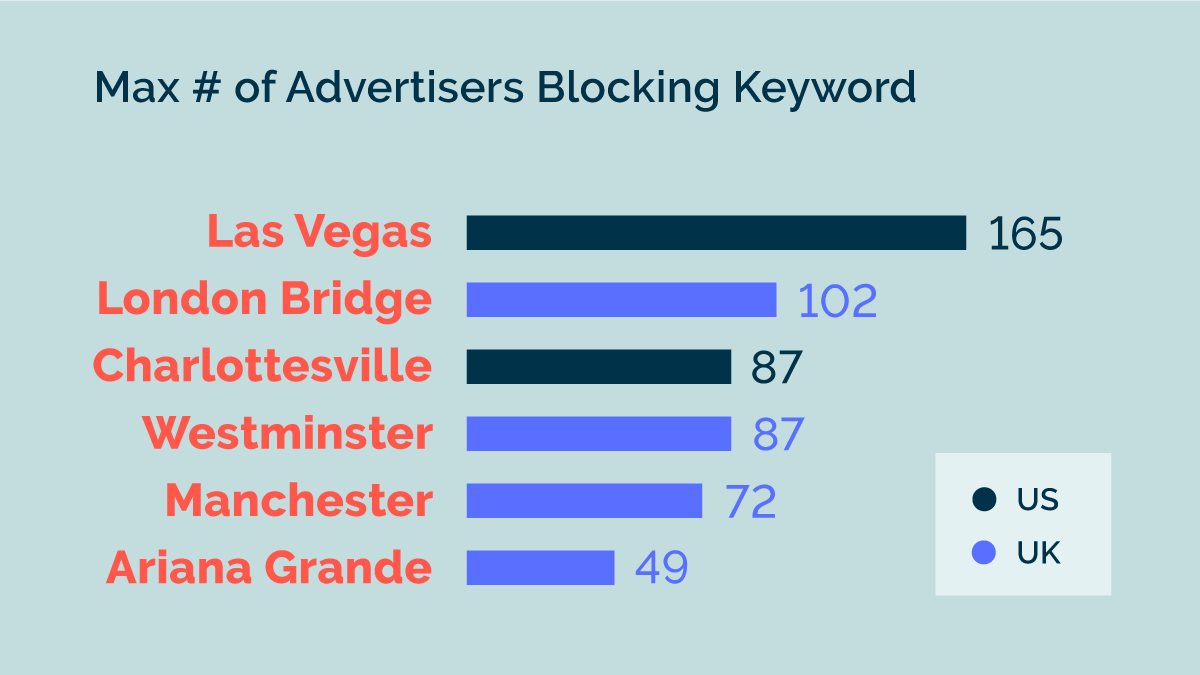
Managing brand safety in digital has always been a delicate tradeoff between suitability and scale. Advertisers understand the potentially disastrous consequences for their brand image and reputation if their messaging appears next to salacious content. But they also understand that if their brand safety standards are too restrictive, they inadvertently avoid safe content, negatively impacting reach.
Most advertisers use brand safety blocking to ensure their ads do not appear next to content deemed unsafe. An example of this might be a children’s brand blocking their ads appearing next to adult content. An additional layer of brand protection that is often employed by advertisers and agencies is keyword blocking, the ability to prevent ads appearing next to content containing specific words. For the family-friendly brand, this may be blocking the keyword “porn”.
Keyword blocking mostly comes into play when brands are thinking of their reputation in regards to current news affairs. For example, if there has been a terror attack, a fatal shooting or an extremely negative news story, many brands will not want to appear alongside these articles. Consequently, advertisers may block specific keywords related to these breaking news stories, preventing them from appearing next to any associated online articles.
In theory, this sounds like a proactive and preventative plan. However, excessive keyword blocking can have a negative campaign impact. A campaign with numerous keywords on a blocklist will become overly restrictive and ad spend will not have the opportunity to be effective. At IAS, we often see that keywords lists are being continuously added to and are not revised as they should be.
Often, outdated keywords remain on blocklists well after the term is no longer related with the breaking news story. IAS identified blocked keywords within our data set that were previously unsafe due to a breaking newscycle, but are not risky terms in themselves. Examples in the UK included: ‘Ariana Grande’, ‘Manchester’ and ‘London Bridge’, following the terror attacks. The graph below shows the number of advertisers still choosing to block these terms today, along with US examples, ‘Charlottesville’ and ‘Las Vegas’ also continuing to be blocked today.

While most of these keywords were once associated with a breaking newscycle , it does not make sense to avoid all related content – particularly two years on. For example, would a travel brand want to avoid advertising near pre-match analysis of an upcoming “Manchester” City game? Would a music streaming service not want their advertising to appear alongside “Ariana Grande” – one of the world’s top 10 recording artists?
For brands and publishers alike, there are significant missed opportunities here. The excessive use of keyword blocking has the power to notably impact the efficacy of marketer’s spend, reduce the reach of campaigns and miss out on valuable brand safe placements that hold the best opportunity to reach engaged consumers. For publishers, their valuable inventory is being passed over and blocked – particularly news publishers, where their engaged and valuable audiences are not going to be reached whilst they are reading controversial, yet factually reported, news updated every minute. These outdated blocked keyword lists can only represent a hugely wasted opportunity for both sides of the advertising ecosystem.
So, what to do? Whilst a ‘one-size-fits-all’ approach will not work for each unique brand’s offering and requirements, ensure you are asking yourself these questions when it comes to keyword blocking:
“Will my brand safety tool already address this content?”
It is important to understand that brand safety blocking done at the content category level – such as, adult content, or illegal drug content – should be sufficient to block ads against undesirable content. The additional layer of keyword blocking can be truly unnecessary and the term will already have been blocked based on your brand safety tool settings.
“Do I still need to block this word?”
Try not to treat a keyword blocklist as something that should continue to grow – instead, it should be checked and refreshed at the very least every month. This will ensure that you open up a campaign to new brand safe inventory. Advertisers should ask themselves – does it still makes sense to block this term? And if so, how long will I continue to block it?
“Which keywords are non-negotiable for my brand?”
And finally, be clear on your non-negotiable keywords – which terms will you always want to block?
We all have a responsibility to work together to find a solution to how to protect brands around controversial news topics – we must address these challenges and educate those across the digital ecosystem. If we are to fully tackle the challenge, then each corner of the industry must be accountable for understanding how and when blocking solutions should be implemented. At IAS, we are working with the IAB UK to find an industry-agreed solution, build best practice and form a working group to ensure collaboration and education. We are also working to refine our own comprehensive brand safety solution to protect brands without limiting scale across publishers. Our data scientists are looking to the ways in which we can improve our machine learning to understand the nuances associated with low and medium risk content thresholds. It’s a solution that is continually being worked on and we’re committed to finding a solution that works for everyone.
Brand safety preferences will always come down to individual risk appetite and it’s important to remember that brand safety is not a new problem – it will never go away because ads live next to content. There will always be content that can be deemed inappropriate at some level, for some brands. Although, it never hurts to do a little spring cleaning and ensure that any keyword blocking is still relevant and working as desired. This will ensure advertising spend if most effective and not being removed from appearing next to great content, where your spend has greater opportunity to make an impact.
Interested in learning more? For additional insights on brand safety, click here to download our brand safety essential guide.
 Share on LinkedIn
Share on LinkedIn Share on X
Share on X


